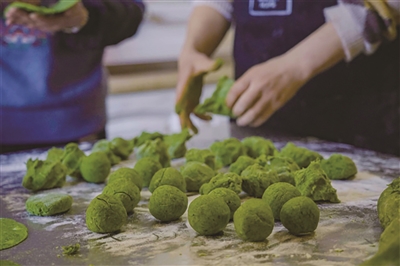
Photo provided to Hangzhoufeel
By Guan Can
Qingtuan, a mugwort-flavored green rice dumpling, is a spring delicacy made of sticky rice dyed a vibrant green with mugwort juice. It symbolizes renewal and is traditionally shared during China's Qingming Festival.
Imagine biting into a pillowy, emerald-hued parcel that tastes like misty river towns and blooming fields--they’re the ultimate taste of spring. In the Jiangnan region (the Lower Yangtze Delta), this springtime treat goes by many names and takes many shapes: in Suzhou, they're known as “Qingtuanzi”, in Nanjing, “Chuntuan”, and in Hangzhou, “Qingguo”. You’ll find them round like full moons, flattened like river stones, folded like lotus leaves, or angled like pagoda eaves--but whatever the shape, every bite bursts with the fresh flavors of spring.
From ancient dumplings to modern obsession
These vibrant green dumplings trace their origins to the Cold Food Festival, an ancient tradition when people refrained from lighting cooking fires to honor the dead--so they stuffed their pockets with herbal snacks instead. Texts from the Tang Dynasty first mentioned Qingtuan. Song Dynasty artisans perfected the mugwort-infused emerald glaze. By the Ming and Qing eras, they had become the go-to offering for family ancestors. During the Taiping Rebellion(Year 1851-1864), rebel leader Li Xiucheng famously escaped by hiding in baskets of Qingtuan, turning these dumplings into instant legends.
Today in Hangzhou, making Qingtuan isn’t just cooking--it’s a ritual embedded in local tradition. The magic happens step by step:
Wild mugwort picked at dawn (elders swear the morning dew adds sweetness)
Rice dough kneaded till jade-green (granny-approved elbow grease required)
Various fillings hugged tight (no leaks allowed--this is serious business)
From village kitchens to city bakeries, the recipe has lived on for centuries. Why? Because every fold in that dough carries stories--of hungry farmers, clever cooks, and grandmas who knew spring’s first bite should taste like hope.
These chewy green delights come in three styles: savory, sweet, and even spicy! Traditional versions burst with fillings like pork, bamboo, and salted egg yolk or black sesame with red bean paste. But modern twists are stealing the spotlight: think creamy matcha red bean, taro-cheese explosions, salted egg yolk floss, molten chocolate centers, and airy matcha mousse. From nostalgic flavors to bold mashups, the Qingtuan game just got deliciously unpredictable!
Check out these local favorites for Qingtuan:
Viral sensation: Wang Rong Zongzi (王蓉粽子), Tiancheng Road
Iconic Hangzhou snack franchise: Zhiweiguan (知味观)
Old-school charm: Chunying Zongzi Shop (春英粽铺), Guanjun Road
Steamed perfection: Huili Steamed Cakes (惠立蒸糕), Changshan Road
Hidden gems: Local wet markets like Wangjialong (王家弄菜市场), Baochu Road; Luojiazhuang (骆家庄菜市场), Wenyi West Road.
